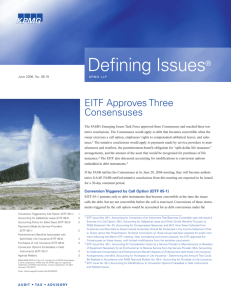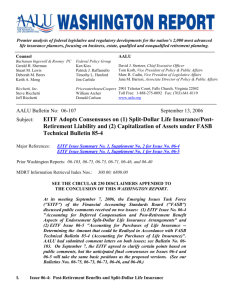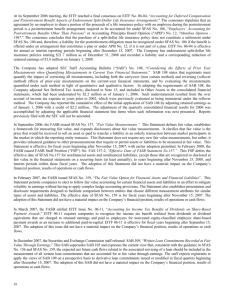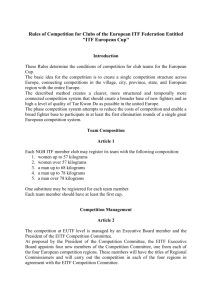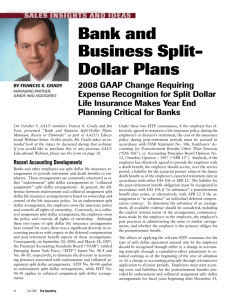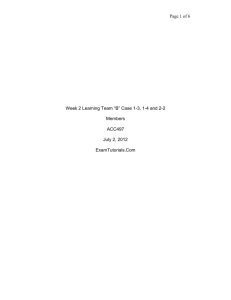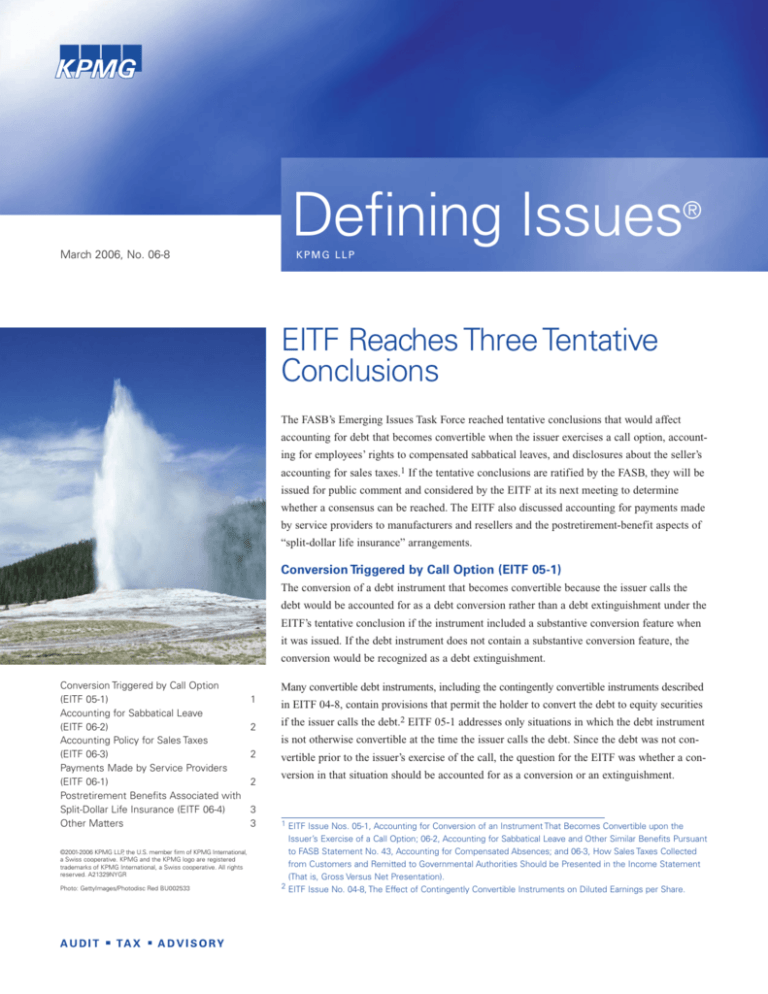
Defining Issues
®
March 2006, No. 06-8
KPMG LLP
EITF Reaches Three Tentative
Conclusions
The FASB’s Emerging Issues Task Force reached tentative conclusions that would affect
accounting for debt that becomes convertible when the issuer exercises a call option, accounting for employees’ rights to compensated sabbatical leaves, and disclosures about the seller’s
accounting for sales taxes.1 If the tentative conclusions are ratified by the FASB, they will be
issued for public comment and considered by the EITF at its next meeting to determine
whether a consensus can be reached. The EITF also discussed accounting for payments made
by service providers to manufacturers and resellers and the postretirement-benefit aspects of
“split-dollar life insurance” arrangements.
Conversion Triggered by Call Option (EITF 05-1)
The conversion of a debt instrument that becomes convertible because the issuer calls the
debt would be accounted for as a debt conversion rather than a debt extinguishment under the
EITF’s tentative conclusion if the instrument included a substantive conversion feature when
it was issued. If the debt instrument does not contain a substantive conversion feature, the
conversion would be recognized as a debt extinguishment.
Conversion Triggered by Call Option
(EITF 05-1)
Accounting for Sabbatical Leave
(EITF 06-2)
Accounting Policy for Sales Taxes
(EITF 06-3)
Payments Made by Service Providers
(EITF 06-1)
Postretirement Benefits Associated with
Split-Dollar Life Insurance (EITF 06-4)
Other Matters
©2001-2006 KPMG LLP, the U.S. member firm of KPMG International,
a Swiss cooperative. KPMG and the KPMG logo are registered
trademarks of KPMG International, a Swiss cooperative. All rights
reserved. A21329NYGR
Photo: GettyImages/Photodisc Red BU002533
Many convertible debt instruments, including the contingently convertible instruments described
1
2
in EITF 04-8, contain provisions that permit the holder to convert the debt to equity securities
if the issuer calls the debt.2 EITF 05-1 addresses only situations in which the debt instrument
is not otherwise convertible at the time the issuer calls the debt. Since the debt was not con-
2
2
3
3
vertible prior to the issuer’s exercise of the call, the question for the EITF was whether a conversion in that situation should be accounted for as a conversion or an extinguishment.
1 EITF Issue Nos. 05-1, Accounting for Conversion of an Instrument That Becomes Convertible upon the
Issuer’s Exercise of a Call Option; 06-2, Accounting for Sabbatical Leave and Other Similar Benefits Pursuant
to FASB Statement No. 43, Accounting for Compensated Absences; and 06-3, How Sales Taxes Collected
from Customers and Remitted to Governmental Authorities Should be Presented in the Income Statement
(That is, Gross Versus Net Presentation).
2 EITF Issue No. 04-8, The Effect of Contingently Convertible Instruments on Diluted Earnings per Share.
2 Defining Issues March 2006, No. 06-8
The determination of whether a debt instru-
as a change in accounting principle calling
ment has one or more conversion features
Accounting for Sabbatical Leave
(EITF 06-2)
beyond the exercise of the issuer’s call that
The EITF tentatively concluded that an
ods if practicable. The Consensus would be
are substantive is made as of its issuance date.
employee’s right to a compensated absence
effective for the first annual reporting period
The EITF agreed that the issuance date of
under a sabbatical or similar benefit arrange-
beginning after the date of FASB’s ratification.
the instrument would be the same as its com-
ment in which the employee is not required
mitment date, as defined in EITF 00-27.3
to perform any duties during the absence
Although the determination would be made
“accumulates” and, therefore, should be
“as of ” the date of issuance, the assessment
accounted for as a liability if the other con-
need not be made contemporaneously with
ditions for recognition in Statement 43 are
issuance.
met.4 The Statement requires accrual of a
liability for employees’ compensation for
The EITF also agreed that, for purposes of
the tentative conclusion, a debt instrument’s
conversion feature is substantive if it is “reasonably possible” to become exercisable
without being triggered by the issuer calling
the debt. A conversion feature that can
become exercisable only by the issuer calling
the debt would not be a substantive conversion feature.
Some Task Force members observed that in
determining whether a conversion feature is
substantive, it would be appropriate to compare the interest rate on the convertible
instrument as of the date of issuance with
the interest rate that would be required if the
instrument had no conversion features. The
difference might indicate how the marketplace has assessed the likelihood of conversion. The FASB staff will include additional
guidance on making this determination in
future absences over the service period if all
these conditions are met:
l The employer’s obligation is attributable
to employees’ services already rendered;
l The obligation relates to rights that vest or
accumulate;
l Payment of the compensation is probable;
for retrospective application to all prior peri-
Accounting Policy for Sales Taxes
(EITF 06-3)
The EITF tentatively concluded that a company must adopt a policy of presenting externally imposed taxes on revenue-producing
transactions on either a gross or net basis.
Gross or net presentation may be elected for
each different type of tax, but similar taxes
should be presented consistently. Taxes within
the scope of this Issue would include taxes
that are imposed on a revenue transaction
between a seller and a customer—for example,
sales taxes, use taxes, value-added taxes, and
some types of excise taxes.
and
l The amount can be reasonably estimated.
If the taxes are significant, the company would
be required to disclose the adopted policy in
Under an example arrangement discussed by
the notes to the financial statements. If sig-
the EITF, an employee is eligible to take ten
nificant taxes on revenue-producing transac-
weeks off as a sabbatical leave after eight
tions are presented gross, the company would
years of service. During the sabbatical, the
also be required to disclose the amount pre-
employee continues to be compensated but is
sented on a gross basis. Under a final
not required to perform any duties for the
Consensus on EITF 06-3, the disclosures
employer. The right to the compensated
would be required in interim and annual
absence does not vest, because the employee
financial periods beginning after December
is not entitled to payment for unused sabbati-
15, 2006.
cal leave upon termination of employment.
employer’s obligation for the sabbatical
Payments Made by Service
Providers (EITF 06-1)
accumulates and should be recognized as a
The EITF discussed the accounting for cash
The final Consensus on EITF 05-1 is
liability. Sabbatical leaves that obligate the
or other consideration that providers of serv-
expected to be effective for conversions that
employee to perform research or other serv-
ices that depend on specialized equipment
occur as a result of the issuer’s exercise of a
ices during the sabbatical period are excluded
pay to manufacturers or resellers of the spe-
from the scope of this Issue.
cialized equipment.5 The services might, for
the draft abstract that will be issued for public comment.
call option in interim or annual periods
beginning after the date the FASB ratifies a
final Consensus, regardless of when the
instrument was originally issued.
However, the Task Force concluded that the
example, be cable or satellite TV or radio
A liability for sabbatical leaves in accordance
services or security services. The payments
with a final Consensus would be recognized
may be incentives to reduce the selling price
3 EITF Issue No. 00-27, Application of Issue No. 98-5 to Certain Convertible Instruments.
4 FASB Statement No. 43, Accounting for Compensated Absences, November 1980, available at
www.fasb.org.
5 EITF Issue No. 06-1, Accounting for Consideration Given by a Service Provider to Manufacturers or Resellers
of Specialized Equipment Necessary for an End-Customer to Receive a Service from the Service Provider.
©2001-2006 KPMG LLP, the U.S. member firm of KPMG International, a Swiss cooperative. All rights reserved. A21329NYGR
3 Defining Issues March 2006, No. 06-8
of the specialized equipment in order to
ance arrangements, the employer purchases a
employees whose terms may permit redemp-
stimulate end-customer demand for the serv-
life insurance policy to insure the life of an
tion of the share option or underlying share.8
ices. These types of incentives are common
employee and enters into a separate agree-
The staff believes that the initial amount
during the initial stage of a service’s intro-
ment that splits the policy’s premiums and/or
classified outside of permanent equity should
duction to the market when the cost of the
policy benefits between the employer and
be based on the redemption provisions of the
specialized equipment may be prohibitive to
the employee. The employer owns and con-
instrument. For example, upon issuance of a
some end-customers. The incentives could
trols the policy, and the employee designates
fully-vested share option that allows the
be in the form of cash, equity instruments,
his/her beneficiary for the employee’s portion
holder to put the share option back to the
technological know-how, key components of
of the death benefits.
issuer at its intrinsic value upon a change in
control, the intrinsic value of the share option
the specialized equipment, or tooling.
The Task Force discussed whether an
The Task Force discussed whether these types
endorsement-type split-dollar life insurance
of incentive payments are within the scope
arrangement “embodies” an obligation to the
of EITF 01-9 and, if so, how its Consensus
employee that should be recognized as a lia-
would be applied.6 Part of the discussion
bility by the employer. The members also
focused on the degree of linkage between the
considered whether the purchase of the policy
incentive payment made by the service
effectively settles any obligation and how the
provider and the service provider’s contract
economic sacrifice of a portion of the death
with the end-customer. The Task Force also
benefit, which would otherwise be retained
considered whether to develop a new model,
by the employer, should be reflected in the
separate from EITF 01-9, for these arrange-
financial statements. The Task Force plans to
ments. The Task Force plans to discuss this
discuss the issue further at future meetings.
issue further at future meetings.
Other Matters
Postretirement Benefits Associated
with Split-Dollar Life Insurance
(EITF 06-4)
The SEC staff clarified the application of
The EITF considered the accounting for the
ered some agenda items and agreed to mod-
deferred-compensation or postretirement
ify the Consensus in EITF 05-7. The Task
benefit aspects of an endorsement-type split-
Force Chairman also announced changes in
dollar life insurance arrangement.7 Companies
the EITF’s operating procedures that became
purchase life insurance for various reasons
effective as of the March meeting.
EITF D-98 to share-based-payment arrangements with employees, and the EITF consid-
that may include protecting against the loss of
at the date of issuance would be its redemption amount and should be presented outside
of permanent equity. The clarification also
refers to other guidance in EITF D-98 that
should be followed to determine the amount,
if any, of subsequent adjustments to the
redemption amount. The redemption amount
for partially-vested awards is measured based
on the proportionate amount of employee
service rendered to date.
Agenda Items. The EITF added to its agenda
Issue No. 06-D, “Accounting for Purchases
of Life Insurance – Determining the Amount
That Could be Realized in Accordance with
FASB Technical Bulletin No. 85-4, Accounting
for Purchases of Life Insurance.” The Agenda
Committee discussed “Transactions Involving
the Purchase of Financial Assets and Simultaneous Repurchase of the Same Financial
Assets with the Seller,” but deferred making
a decision on whether to add that issue to the
“key” employees, funding deferred-compen-
SEC Staff Announcement on EITF D-98.
EITF agenda until the FASB decides whether
sation and postretirement benefit arrange-
The SEC staff clarified its position on the
to provide guidance on the subject.
ments, and providing investment returns.
application of EITF D-98 to share options or
similar instruments granted in conjunction
In endorsement-type split-dollar life insur-
with share-based payment arrangements with
6 EITF Issue No. 01-9, Accounting for Consideration Given by a Vendor to a Customer (Including a Reseller of
the Vendor’s Products).
7 EITF Issue No. 06-4, Accounting for the Deferred Compensation and Postretirement Benefit Aspects of
Endorsement Split-Dollar Life Insurance Arrangements.
8 EITF Topic No. D-98, Classification and Measurement of Redeemable Securities. The accounting for these
arrangements was previously discussed in KPMG’s Defining Issues No. 06-3, Revised Statement 123R
Classification Requirements for Contingently Cash-Settleable Share Options and Related Guidance for Public
Companies.
©2001-2005 KPMG LLP, the U.S. member firm of KPMG International, a Swiss cooperative. All rights reserved. A21329NYGR
Consensus Modification (EITF 05-7). The
Task Force agreed to clarify that the
Consensus in EITF 05-7 on accounting for modifications to conversion options embedded in
debt securities also applies to a modification of a debt instrument that either adds or eliminates an embedded conversion option.9 The EITF 05-7 Consensus arrived at during the
September 2005 EITF meeting requires an issuer, upon modification of a convertible debt
instrument, to include the change in fair value of the related embedded conversion option in
the analysis to determine whether a debt instrument has been extinguished pursuant to EITF
96-19.10 However, the Task Force observed that EITF 05-7 provides no guidance on how to
apply EITF 96-19 to modifications of debt instruments that add or eliminate embedded conversion options that are required to be bifurcated from their hosts under Statement 133.11
Operating Procedures. The EITF’s operating procedures are modified as of the March 2006
meeting. The changes include the following:
l Prior to reaching a Consensus on an Issue, a tentative conclusion must be established and a
draft abstract based on that tentative conclusion must be issued for public comment with a
minimum 15-day comment period.
l Prior to issuing the draft abstract for public comment, the FASB must ratify the tentative
conclusion and approve its exposure for public comment.
This is a publication of KPMG’s
l The Task Force is to consider comments on each draft abstract at a future EITF meeting
before determining whether to approve the tentative conclusion as a Consensus.
Department of Professional
Practice—Audit and Risk Advisory
212-909-5600
All final EITF Consensuses will continue to be subject to ratification by the FASB at a public meeting held prior to the distribution of the final EITF minutes. An EITF abstract is not
considered part of the GAAP hierarchy until the final Consensus is ratified by the Board.12
Ú
Contributing authors:
Mark M. Bielstein
Landon B. Westerlund
Robert B. Malhotra
Brian C. Stevens
Earlier editions are available at:
www.aro.kpmg.com
Defining Issues® is a registered trademark of KPMG LLP. © 20012006 KPMG LLP, the U.S. member firm of KPMG International, a
Swiss cooperative. KPMG and the KPMG logo are registered trademarks of KPMG International, a Swiss cooperative. All rights
reserved. A21329NYGR
Ú
Ú
The Task Force is expected to consider public comments on the tentative conclusions described
above at the June 14-15, 2006 EITF meeting to determine whether to approve the tentative
conclusions as final Consensuses.
The descriptive and summary statements above are not intended to be a substitute for the
text of the EITF’s Consensuses, tentative conclusions, or official minutes; FASB Statements;
SEC staff announcements; or any of the other potential or actual requirements. Nor are any
of the cited documents necessarily applicable to any entity’s specific circumstances. In
determining the appropriate accounting treatment for a transaction, one should refer to the
texts of the applicable documents that set out requirements, including the formal EITF meeting minutes that will be made available on the FASB Web site, and consult their accounting
and legal advisors.
9 EITF Issue No. 05-7, Accounting for Modifications to Conversion Options Embedded in Debt Securities and
Related Issues.
10 EITF Issue No. 96-19, Debtor’s Accounting for a Modification or Exchange of Debt Instruments.
11 FASB Statement No. 133, Accounting for Derivative Instruments and Hedging Activities, June 1998, avail-
able at www.fasb.org.
12 The Task Force’s operating procedures are available on the FASB website at www.fasb.org/eitf/eitf
_operating_procedures.pdf.

